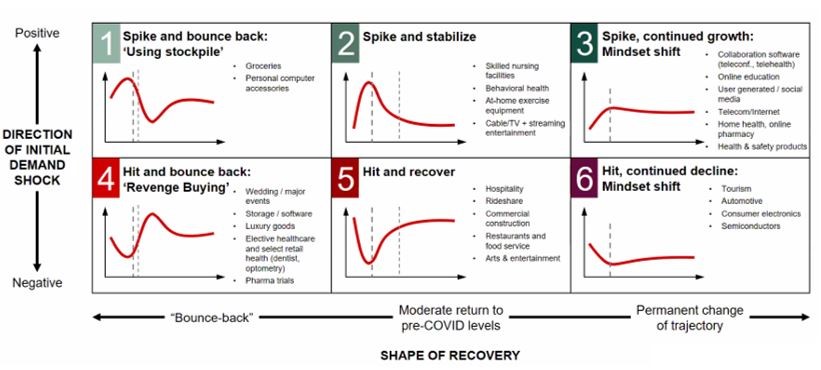
Six steps to results
It is an understatement that we are navigating turbulent waters due to Covid-19. Both demand and supply outlooks are very unpredictable. Together with our customers we developed and implemented Scenario Planning and Management capabilities, ready-to-run scenario planning, in the past few years. It is very strong to experience the powerfulness of those capabilities in the current Covid-19 period. Therefor we want to share our experiences.
We are navigating turbulent waters. All over the world Covid-19 causes disruptions in Supply Chains and has impact on business (lead times, revenues), manufacturing & capacity, transportation & logistics. Not only supply side, there are also big shifts in consumer behavior. We see huge fluctuations in demand and it changes day by day, among other resulting in shortages many of us have never experienced before. And what is the outlook, what is the shape of recovery? Districon is convinced that it is a must to have Scenario Planning and Management capabilities. It enables fact-based decision making.

What is SCENARIO PLANNING?
Porter describes Scenario Planning as follows: “A scenario is an internally consistent view of what the future might turn out to be - not a forecast, but one possible future”. We could translate this as answering two main questions: What could happen? What would be the impact?
Scenario Planning has value in any situation in which there is significant uncertainty about aspects of the future that could materially change an organization’s strategy, plans or decisions. We would like to highlight that scenario planning is applicable not only for negative scenario’s, but also to show the opportunities of business innovation, e.g. new product development. Or opportunistic growth strategy versus a cautious strategy. In fact, it is restricted only to your own creativity. How can you stimulate demand in other sectors? Are there companies you could potentially partner with to stimulate growth? What does it mean for you when regions become Covid-19 free? What products will they buy? What happens if a competitor cannot supply certain regions because of regulations or lock downs? What about cross border transport restrictions?
Why next generation SCENARIO PLANNING?
Most companies will indicate that scenario planning is already embedded in their decision-making process. However, in practice it is often limited to changing parameter values in Excel spreadsheets and checking the impact of a change. Or has primarily been used to test strategic scenarios such as how many distribution centres are needed, and where to locate them.
We believe this does not suffice anymore. We need tools to help us make fast, sound tactical decisions when it really matters. Although experience and judgement must be used alone when there is no other option, most supply chains are just too complex for this to be enough.
Spreadsheet calculation is not the recommended way to deal with the current crisis nor to find the early pattern signals. Using more sophisticated (combination of) tooling can bring much more additional value by embedding a multi-dimensional mindset. It enables decision makers to evaluate scenarios quickly and decide in a data driven way by making use of the benefits of these sophisticated tools:
- Work with real time & diverse sets of data
- Think multi-dimensional, what will be the impact of several combined changes?
- Demand changes fast so you need faster calculations and aster insights
- Enable multi-user collaboration, especially now critical when everyone is working from home
- Optimize/prescribe decisions: what are the recommended actions to take?
- Easily calculate and compare hundreds of scenarios
- Quantify risks and assumptions
- Signal trends, patterns
- Implement new AI/ML techniques able to work with almost no historic data
- Empower strong visualization options, including dashboarding
Six step approach to results
Districon takes into account 6 critical steps, which we will present briefly.
- Before embarking upon a scenario-planning exercise, it is essential to be clear about the issue that you are seeking to address and then define the appropriate scope and time horizon for the scenarios to be constructed. Answering the following questions can assist:|
-What issues or decisions are being evaluated?
-Is there a high degree of uncertainty about the future environment?
-What is the time horizon for making decisions and then executing against them? - The heart of an effective scenario plan is to identify the right drivers around which to construct the scenarios. In the context of scenario planning, drivers are internal and external factors that could influence the future environment. This definition is very broad, so it is important to develop reasonable criteria for identifying those that are material to the organization or issues being addressed.
- When embarking on the development of scenario plans, the data collection net should be cast widely. Numerous types of data can be collected, including historic trends, future projections and forecasts, insights as to potential sources of disruption, alternative hypotheses of the future, and analyses of the relationships between key drivers. Having collected the base data, the next step is to identify the relative impact and predictability of the drivers.
- The essential task of scenario planning is developing the actual scenario. You need to build a condition according to each factor you have evaluated in the first steps and create a situation according to for example the traits and trends of the market. Proper scenario development is equivalent to writing a movie scene. You need to build a plot, and then you need to develop your story around it.
- The first step after completing the scenario development is to test the sensitivity of strategies, plans, and budgets under different scenarios by asking, “What will be the impact?”. Developing an understanding of the validity of different strategies and plans under different scenarios gives management a much clearer understanding of the risk factors and the appropriate risk mitigation and management techniques that may need to be employed.
- Some organizations treat scenario planning as a one-off exercise or project. There is certainly merit in using scenario planning in this way, particularly as the effort required can be significant. However, in today’s increasingly volatile world, the future rarely is predictable, so many organizations are adding scenario planning as a core tool in their management toolbox.
Updating scenarios can be a simple process of revisiting steps 2, 3 and 4 by refreshing the data and then assessing the impact of any material changes in the scenarios on current operations and future plans. The most critical element is to avoid assuming that the same relationships between key drivers and results remain the same.
Our final tips and tricks
- Start with what you have. Do not wait on clarity, you will not get soon. It is an iterative process, you learn as you go. Not yearly, not monthly, not even weekly is not good enough in this crisis
- A common trap is to be paralyzed by the multitude of possibilities. Don’t try indefinitely new combinations of uncertainties to build your scenarios. Keep it simple and focus on two major uncertainties.
- Another common mistake is to believe that you have to choose one particular scenario and build your strategy around it. Scenario planning is not about choosing just one option for the future but rather dealing with all the possible outcomes to develop a strategy that will stand the test of all scenarios.
- One of the criticisms of scenario planning is that it can become a largely conceptual exercise with little practical application. It is a valid criticism but not of the technique itself but more of how the results are used (or more accurately not used). Too often organizations pour a lot of effort into developing rich scenarios but fail to apply them in the planning and decision-making process.
